Norton Interpol 1969 History
Bikes
Norton Interpol History 1969-1976 (Illustrated)
This model of the Commando was designed by Neale Shilton specifically for the police in home and export markets. The Interpol is one model that nearly didn’t get made, but went on to become one of the longest running Commando models. It was unveiled in 1969 and produced from 1970 to the end in 1976. Based mainly around standard machines with some special parts, its trade-mark was the white paintwork and addition equipment for police work, including fairing, tank, seat, lights and horns. These were things that Neale had first developed when designing the police version of the Atlas - things that were requested by his former Triumph clients from when he was the sales manager there.
With the introduction of the Interstate and its improvements, the machine benefited by having a longer range and better stopping power. With the new tank came a revised seat, but, more importantly, came the general shift to rear mounting of all the radio equipment, something that was pioneered by Lancashire Constabulary a few years earlier. The rear mounting of the radio and control unit meant it was safer for the rider in an accident involving going over the tank.
Police forces still took delivery of vehicles with fork gaiters and/or shrouded rear units, after they were dropped from the other models. They helped to reduce the effects of the weather and eased the cleaning of machines in use all year round. Other styles of fairings, panniers and signs appeared. From about 1973, the fiberglass add-on’s were slightly re-designed, giving a more rounded look in keeping with the Interstate style. Fairings had in-built indicator mounts now, Craven had a new design of pannier, and Avon produced panniers as well as fairings. The front mudguard widened to accommodate the now standard 4.10x19 TT100 tyre, but mudguards could be standard sports (painted white) or the deeper sided fiberglass police specials. It was also the year that 850cc production started and 750cc stopped.
Various changes in the other Commando models were reflected in the Interpol, including the change from right to left hand gear change, an electric starter and adjustable Isolastic mounts. By September 1975 the final form was reached and no more development done as the model was discontinued in 1976. CLP were making Avon fairings of a new design, similar to what we had seen on early BMW's but to suit the later Norton and Triumph machines. Most users were fitting the earlier style of panniers again.
Norton Interpol Demonstrator
Brighton 1969 saw the first public showing of the original demonstrator.
Note the early style domed chain-case, chain-guard and knee grips on the tank.
The tail pod is also finished in white.
The radio is a (dummy) Cossor CC104 fitted into a specially built Atlas style tank.
Also fitted is a Lucas L564 flashing blue light in the screen and a Craven 'Spaceman' topbox on the carrier.

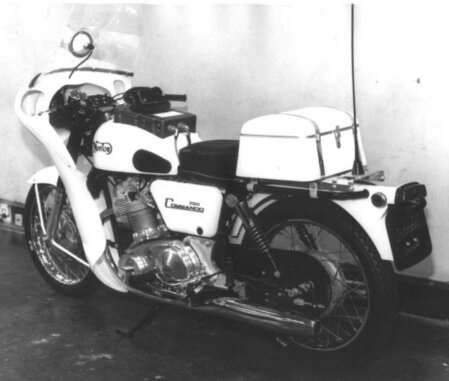
The Second style of Demonstrator Interpol
The machine on the left is believed to be the second demonstrator.
If so, then this, or at least one like it, was ridden by its creator Neale Shilon, to show his previous customers of Triumph and other police motorcycles in the UK and abroad.
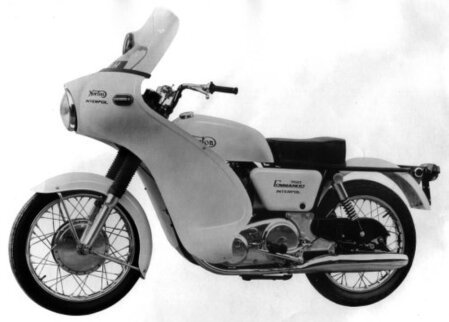
Although the Interpol model appeared in Norton’s sales literature, spares lists and repair manuals, the very nature of its work for the police meant that almost every batch was different due to customer options. Similarly, not all that you see was actually completed in the factory. Norton made the machine with the appropriate tank and single seat and finished it in white or optional black. Factory fitted fairings and panniers were often specified but these, like other additional equipment, could be added by the customer or to the customers requirements by an outside specialist, in which case it would be supplied minus headlight brackets, as they get in the way of the fairing. It should be noted that the Interpol could also be supplied 'naked' (to use modern parlance).
Early versions started out with a modified Atlas tank (in one of four variants to accommodate the radio) and an Avon fairing. There were four versions of the tank, with the tops as used on the Atlas but with a base to suit the Commando. The general idea of fitting a non-radio version to the Interpol was to protect the rider from injury should he have the misfortune to be thrust over the tank in a head-on collision. The non-radio version also went on to be used on the Fastback LR.
Subsequently, the Norton Northway fairing, also made by Avon, was designed and fitted as required, and usually accompanied by Craven panniers. Some machines also had rear crash-bars. For a short period, a unique set of exhaust pipes were fitted, allowing the Interpol to use the new, normally up-swept, reverse cone (pea shooter) silencers at a low level to suit to fitting of panniers. Later machines used standard systems. During 1972, Norton and Lockheed had developed disc brakes which became available later in the year. They could either be factory fitted or supplied as a conversion kit for the user. The fitting of a master cylinder to a machine with a fairing accounted for the Interpol having its own unique set of handlebars for a few seasons.
Extra equipment could include the fairing (if not factory fitted), panniers, top box and the hardware to mount the radio or auxiliary equipment. New lights, horns and signs could be fitted but the police sometimes saved costs by refurbishing and reusing serviceable items from withdrawn machines. All or any of the work could be performed by an outside firm or often by the police mechanics.
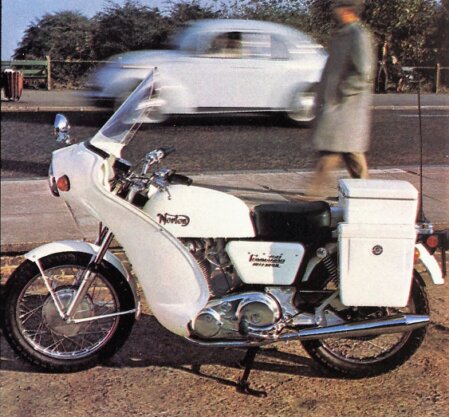
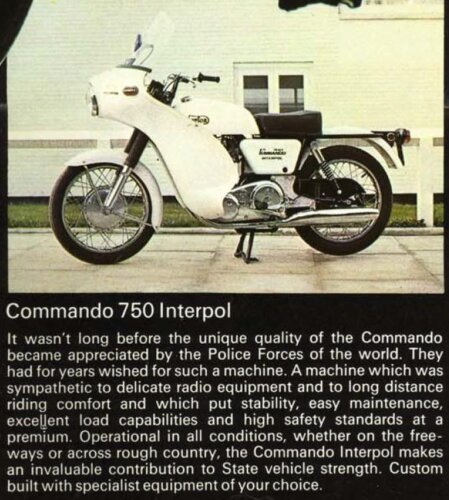
Spot the difference
These are publicity and sales photographs from the factory sales leaflets.
(On a desktop, left picture is from 1971 and on the right is from 1972.)
The knee grips have gone and indicators are now standard Lucas type.
Relays for the horns and flasher unit are fitted in the side panel.
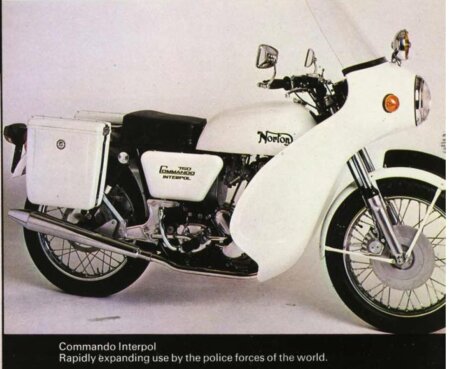
(left) 1973 and it's stll a 750cc engine, but not for long. This machine looks very much like the one from the previous year. The really big changes are the front disc brake and the use of the 'Northway' fairing. This one is still using the old style rear wheel, with three sleeve nuts and grommets to match, but with the later up-swept exhaust beneath its panniers. The radio-less style tank and amber front light might mean its going to be tried with Lancashire Constabulary.
(Right) This 1974 model has the later, squarer Northway fairing, sometimes referred to as a Mk3. In common with early 850s, this still has the disc brake on the right. A PMG Thorpe blue light is fitted as are two-tone air horns. The silencers are the later type used to quieten the exhaust note, but were not popular. The front mudguard has reverted to the deep style (at least on this machine) and a front number-plate is no longer a legal requirement.
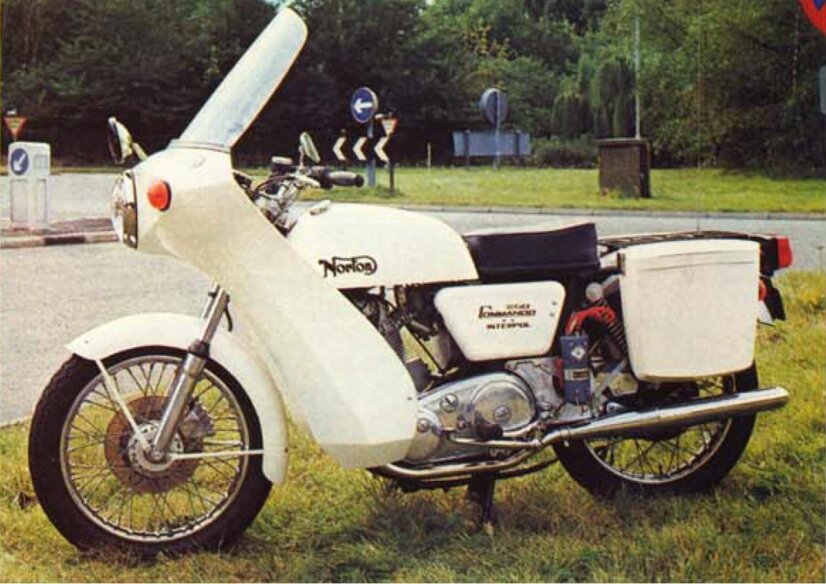
In 1974, in the UK, County boundary's were changed meant re-arrangements to the corresponding police force boundaries and the creation of some new ones - the Metropolitan Counties.
Many machines still covered the same ‘patch’, but were now part of a different police authority, each of which was setting new standards of uniformity and usually required a change of radio equipment.
Many forces, old and new, standardised on a larger, non weather-proof radios as used in the cars. One such radio was the Pye Whitehall. This was based on the Westminster but it was longer and not waterproof and that meant housing it in a fibreglass box on the rear of the machine. Often this meant that the ‘police-stop’ sign was also relocated or changed. This change, coupled with redesigned traffic stripes and force crests meant the bikes’ appearance changed considerably but the machine underneath was mechanically the same.
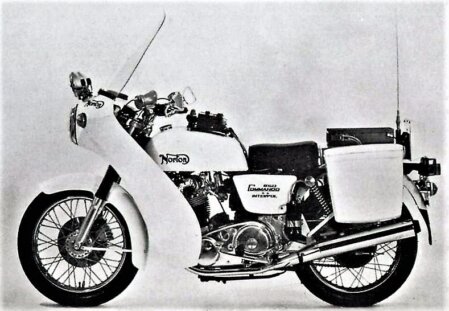
(Left) This 1973 machine is still developing. Now with twin blues, and air horns. It has the later tail light, but still the earlier seat and tank. A Storno radio is fitted, with its control unit fitted to the threaded holes in the tank. Also note the 'Black Cap' silencers.
(Right) The 850cc Interpol for 1974/75. It is based on the 850cc Interstate Electric Start, prior to the brake and gear change lever swap over. It has the Interstate Tank with the new seat, discs front and rear and Black Cap silencers. It has twin blue lights in the London style fairing together with Avon panniers. To the rear we have the later style 'Police/Stop' sign and a local mounted Pye Westminster radio.

1976/77 and the Interpol has reached its final stage of development and the last few Interpol's have been assembled. Now they have the latest fairing, electric start, discs front and rear, left foot gear change, right foot brake and the big Interstate tank and all that goes with it.
The final 1500 Commando's were made in 1977, ending in September that year. By now, BMW's and others were being tried on the UK's roads, all kitted out like their predecessors. The BMW's initially had Avon fairings and Craven panniers.

One machine is seen outside the factory
The other is now in preservation.

Later in 1977, funds became available for Norton to develop a rotary engined machine, which became the Interpol 2.
This was also the year BMW introduced the RT fairing, which became their standard for police work. In order to fit in with existing fleets, Norton fitted the Interpol2 with a fairing that looked very similar to the RT, although on inspection it was very different.